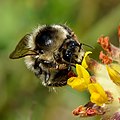Anthyllis vulneraria,[3] the common kidneyvetch, kidney vetch[4] or woundwort[5] is a medicinal plant[6] native to Europe. The name vulneraria means "wound healer".[7]
Description
Anthyllis vulneraria reaches 5–40 centimetres (2.0–15.7 in) in height. The stem is simple or more often branched. The leaves are imparipinnate, glabrous or with scattered hairs on the upper face and silky hairs on the underside. The flower heads are spherical in shape and 10–20 millimetres (0.39–0.79 in) long. The petals are yellow in most sub-species, but red in A. vulneraria var. coccinea. Flowering takes place between June and September. The fruit is a legume. The fruits ripening takes place from July to October.
Kidney vetch is the food plant of the small blue butterfly larvae and the leaf miner, Aproaerema anthyllidella.[8]
Distribution and habitat
This plant is sporadic throughout Europe, from Iceland to the Mediterranean, in Asia Minor up to Iran, in North Africa and in Ethiopia. It is naturalized in North America. It prefers dry grasslands and rocky environments with calcareous soil, up to 3,000 m (9,800 ft) of altitude.
Subspecies
This species includes numerous subspecies (which some authors elevate to the role of separate species). A incomplete list is as follows:
- A. vulneraria subsp. abyssinica (Sagorski) Cullen
- A. vulneraria subsp. alpestris (Kit.) Asch. et Gr.
- A. vulneraria subsp. baldensis (Kerner) Becker
- A. vulneraria subsp. busambarensis (Lojac.) Pign.
- A. vulneraria subsp. carpatica (Pant.) Nyman
- A. vulneraria subsp. colorata (Juz.) Tzvelev (synonym: Anthyllis colorata Juz.)[9]
- A. vulneraria subsp. forondae (Sennen) Cullen
- A. vulneraria subsp. iberica (W.Becker) Jalas
- A. vulneraria subsp. maura (Beck) Lindb.
- A. vulneraria subsp. polyphylla (D.C.) Nyman
- A. vulneraria subsp. polyphylla (D.C.) Nyman × affinis Brittinger ex Kerner
- A. vulneraria subsp. praepropera (Kerner) Bornm.
- A. vulneraria subsp. praepropera (Kerner) Bornm. × adriatica Beck
- A. vulneraria subsp. pulchella (Vis.) Bornm.
- A. vulneraria subsp. vulneraria L.
- A. vulneraria subsp. vulnerarioides (All.) Arcang.
- A. vulneraria subsp. vulnerarioides (All.) Arcang. × bonjeanii Beck
- A. vulneraria subsp. weldeniana (Rchb.) Cullen
- A. vulneraria subsp. weldeniana (Rchb.) Cullen × tricolor Vukot.
- A. vulneraria subsp. weldeniana (Rchb.) Cullen × versicolor Sagorski
- A. vulneraria subsp. valesiaca (Becker) Guyot
Gallery
-
1885 illustration[10]
-
Kidney vetch provides pollen and nectar for a wide range of insects, particularly bumblebees
-
Inflorescences
-
Leaves
References
- ^ Conti F, Guglielmone L, Pennesi R, Bartolucci F (2016). "Typification of the name Astragalus vulnerarioides, basionym of Anthyllis vulneraria subsp. vulnerarioides (Fabaceae), and notes on its distribution". Phytotaxa. 261 (3): 298. doi:10.11646/phytotaxa.261.3.12.
- ^ "The Plant List entry for Anthyllis". The Plant List. Royal Botanic Gardens, Kew and the Missouri Botanical Garden. 2013. Retrieved 16 January 2017.
- ^ Anthyllis vulneraria at USDA PLANTS Database
- ^ BSBI List 2007 (xls). Botanical Society of Britain and Ireland. Archived from the original (xls) on 2015-06-26. Retrieved 2014-10-17.
- ^ "Anthyllis vulneraria". Germplasm Resources Information Network. Agricultural Research Service, United States Department of Agriculture.
- ^ Anthyllis vulneraria at Plants For A Future
- ^ Wolfgang Hensel, 350 Plantes médicinales (french edition: Delachaux et Niestlé SA, Paris, 2008, ISBN 978-2-603-01531-5; German edition 2007 Franckh-Kosmos Verlags-GmbH & Co, Stuttgart, Wolfgang Hensel, Welche Heilpflanze ist das?)
- ^ Kimber, Ian. "843 Aproaerema anthyllidella". UKMoths. Retrieved 15 April 2014.
- ^ "Anthyllis colorata Juz. | Plants of the World Online | Kew Science". Plants of the World Online. Retrieved 15 February 2021.
- ^ illustration from Otto Wilhelm Thomé Flora von Deutschland, Österreich und der Schweiz 1885, Gera, Germany

![1885 illustration[10]](https://upload.wikimedia.org/wikipedia/commons/thumb/8/83/Illustration_Anthyllis_vulneraria0.jpg/73px-Illustration_Anthyllis_vulneraria0.jpg)




Recent Comments